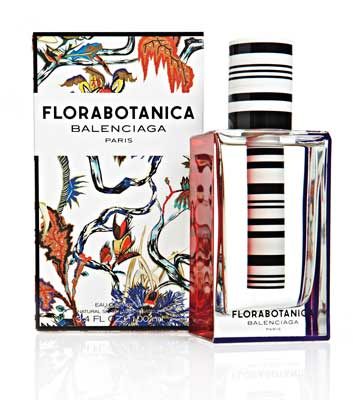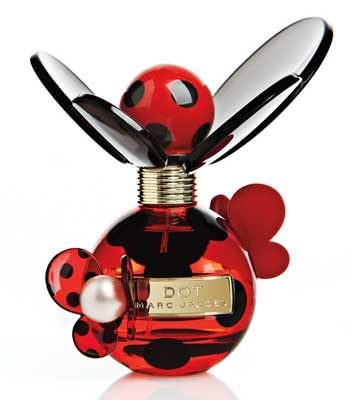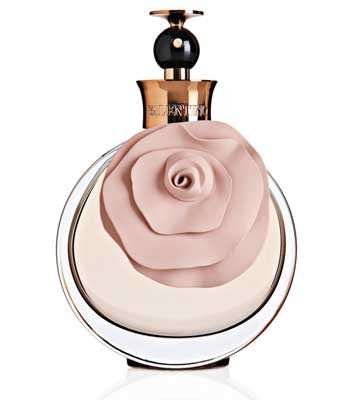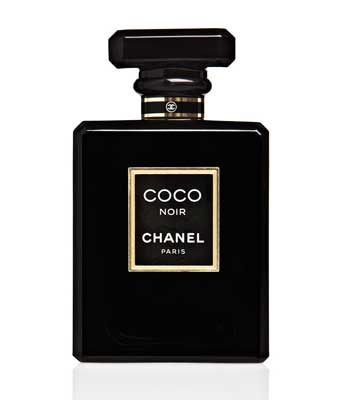
Florabotanica by Balenciago
The designer DNA
Spanish designer Cristóbal Balenciaga (1895-1972) is often cited as being ahead of his time. In the 1950s, he created new silhouettes for women, such as suits that were strictly tailored in front but loose in the back, and the chemise known as “the sack.” Now designed by Frenchman Nicolas Ghesquière, the Paris-based Balenciaga label stays true to Cristóbal’s approach to new fabrications and innovative structure.
The fashion connection
The exuberant print on the Florabotanica box replicates the floral print from Balenciaga’s fall 2011 runway collection. Ghesquière says the scent itself is also inspired by Balenciaga’s floral prints from spring 2008. “A few years ago I designed this floral collection,” Ghesquière has explained. “The dresses were covered with flowers, but these flowers were neither charming nor romantic. I wanted the flowers in this perfume to express the same idea.”
The fragrance
Ghesquière wanted perfumers ( “noses”) Jean-Christophe Héraul and Olivier Polge-son of Chanel perfumer Jacques Polge-to take an experimental approach. Polge told Best Health: “Our creation was strongly influenced by Nicolas Ghesquière’s contemporary vision of fashion and his unique skill for mixing architectural structures, innovative shapes and technological materials.” Ghesquière’s floral prints inspired mysterious roots (courtesy of vetiver) and lush foliage (caladium). And the perfumers took the traditional rose and developed their own experimental one. “We pushed the green, metallic, minty and spicy facets the rose naturally contains,” explained Polge, by adding carnation, which also has spicy facets, and mint. The bottle’s black and white stripes are a nod to vintage Cristóbal Balenciaga, and the centre tube resembles a test tube-representing the experimental, scientific approach of the scent’s creators.

Dot by Marc Jacobs
The designer DNA
A star student at the Parsons School of Design, New Yorker Marc Jacobs started his eponymous collection in 1986. He left it in 1989 to design for Perry Ellis. His still-talked-about 1993 runway show for Ellis-where Jacobs offered up his “grunge” collection with disheveled-looking models in plaid shirts, ripped jeans and black combat boots-had him promptly fired. Thanks to his likeability and cheeky attitude, Jacobs was able to successfully relaunch his own label in 1994. Since 1997 he has also been artistic director of Louis Vuitton in Paris, and now juggles two highly successful labels.
The fashion connection
“As long as I can remember, I’ve always been attracted to round shapes,” Jacobs told Best Health. “I like a sphere. I like a spot. I like a dot. For one of my first collections, the entire collection was polka dots. It began with a sweater I knitted with my grandmother. That’s what sort of started this thing.”
Polka dots continued to be a signature and featured in his fall 2011 collection. And Jacobs notes that his favourite artists, Roy Lichtenstein and Yayoi Kusama, also worked with dots. “Ultimately, it’s a joyous symbol I think is forever and always attractive.”
The fragrance
With the idea of the polka dot being energetic and full of life, New York perfumer Annie Buzantian created a fragrance that reads like a floral smoothie. Its top notes include red berries, dragonfruit and honeysuckle, while jasmine, orange blossom and coconut water make up the middle notes. These are rounded off by vanilla and musk.
Similar to Jacobs’ whimsical approach to fashion, the bottle resembles a ladybug, boasting various sizes of black dots, pearls and a butterfly-shaped cap, all helping to give the bottle and scent animation.

Valentina Assoluto
The designer DNA
Italian designer Valentino Garavani (known in fashion circles simply as Valentino) had a prestigious beginning, studying in Paris at the École des Beaux-Arts and the Chambre Syndicale de la Couture Parisienne. He later established a couture house in Rome and, in 1960 at age 30, showed his first collection. It included contrasting black and white, and a shade of red that resembled red poppies, later known as “Valentino red.” His feminine designs have long been worn by international royalty, socialites and celebrities, and are a favourite on the red carpet. A celebrated designer, Valentino was honoured with the Legion of Honour by President Chirac of France in 2006. Valentino retired in 2007 at age 75 and lives in Italy. The label is now designed by the creative-directing duo Maria Grazia Chiuri and Pierpaolo Piccioli, both from Rome.
The fashion connection
The Valentina Assoluto scent is inspired by haute couture. The bottle’s shade, dark nude, became prominent in Valentino’s later couture designs. (Today, only a handful of fashion houses create haute couture-handmade garments custom-made by seamstresses, using expensive and exquisite fabrics.) With Chiuri and Piccioli at the helm, the couture continues to honour the Valentino aesthetic-delicate lace, antique-looking florals and layers of organza. The blush flower and black cap represent Valentino’s signature couture colour palette, while the fabric flower is also an emblem of Valentino couture.
The fragrance
“We wanted to create a more sophisticated, precious and intimate version of Valentina [the scent that debuted in 2011],” Paris-based perfumer Olivier Cresp explained to Best Health about his collaboration with Chiuri and Piccioli. Cresp, who is also the nose behind Valentina, explained, “To my mind, Valentina Assoluto is more sensual, mysterious and exuberant, but it also asserts a new sophistication.”
To make a scent that was more intense and enveloping, he developed Valentina Assoluto in the chypre-floral family. The fragrance has peach and white truffle in the top notes, vanilla and white flower bouquet (orange blossom, jasmine and tuberose) in the middle notes, and Italian chypre floral and patchouli in the base. It’s like haute couture in a bottle.

Coco Noir by Chanel
The designer DNA
Born in 1883, Gabrielle (Coco) Chanel revolutionized women’s fashion. At a time when it consisted of confining garments like the corset and lace-up boots, she offered comfortable, stylish alternatives. Inspired by silhouettes and fabrics from menswear, Chanel introduced women to wide-leg pants, espadrilles and sailor shirts. She also invented the little black dress, body-skimming suit jackets with braided trim, and the style of wearing multiple strands of pearls. Chanel No. 5 (created in 1921) was the first fragrance named after its designer, and the bottle’s minimalist design was radical for fragrance bottles then. Chanel died in 1971 at age 87. German-born Karl Lagerfeld took over as designer for the House of Chanel in 1983 and reignited the brand for a new era.
The fashion connection
Chanel found solace in Venice after the death of the love of her life, Boy Capel, who died in a car crash in 1919. Venice, with its colours, ornamentation and Byzantine patterns, would come to influence Chanel’s personal décor style and her later jewellery designs.
Jacques Polge, the House of Chanel perfumer, used Coco Chanel’s time in Venice as his creative jumping-off point for the composition of Chanel Coco Noir. He also took cues from her apartment in Paris, maintained by the company, with its opulent oriental screens and gilded baroque decoration.
The fragrance
Polge, who is the nose of several Chanel scents, including Coco and Coco Mademoiselle, brought the idea of “Byzantine” to Coco Noir by creating a spicy-oriental fragrance that was “dark, mysterious and seductive,” says the House of Chanel. At first spritz, Coco Noir smells of grapefruit and bergamot. Rose and jasmine middle notes (also present in both Coco and Coco Mademoiselle) fold into base notes of tonka bean, patchouli, vanilla, sandalwood and frankincense. The bottle stays true to that simple, pure aesthetic that helped Chanel revolutionize fashion in the 1920s. And the company says the black lacquered finish references the deep, dark waters of Venice-the city behind the scent.
Related
• The truth about fragrance sensitivity
• How to choose the perfect perfume
• Quiz: What’s your perfume scent personality?
